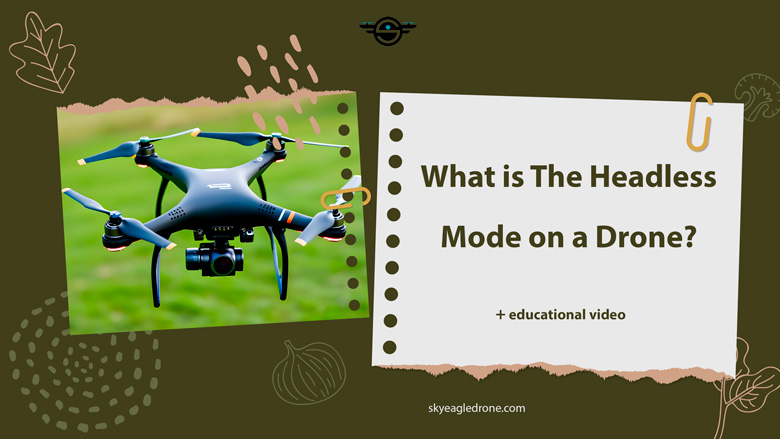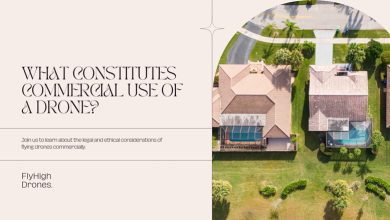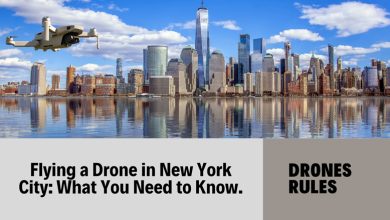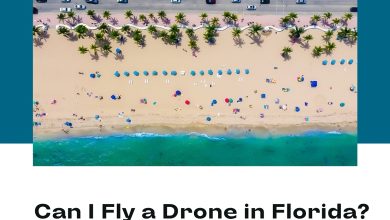What is The Headless Mode on a Drone?

There is an option in new drones, and that is the headless mode; this feature and mode make the use of the drone easier and simpler, especially for users who are using it for the first time.
Drone pilots may now navigate their drones based on their vision rather than the orientation of the machine, thanks to this amazing feature in the realm of drone technology.
In this article, we will ask what is the headless mode on a drone. We examine its features and practical applications.
What does headless mode mean on a drone?
While operating and piloting your drone, you may have encountered the headless mode, but what does headless mode mean on a drone?
The headless mode on a drone is to streamline the guidance process. Headless mode on a drone is designed to simplify the flying experience, preventing confusion about the drone’s orientation.
In headless mode, it is a mode to facilitate the flight process so that you are in control of the direction and movement of the drone.
For example, when using the standard mode without headless, if you want to turn the drone to the left, you need to push the controller forward.
Which is a bit difficult and confusing in difficult situations or when you are a beginner pilot.
But by turning on the headless mode, you can direct the drone in your desired direction by simply adjusting the control button.
This mode allows you to direct the flight according to your vision and direction.
Headless-mode drones simplify the flight control process and enable you to operate the device based on your orientation.
In this case, the constant need to determine the drone’s position is eliminated, attention to its directions is lost, and you can fly your drone with greater concentration and ease.
This guarantees that pilots of all skill levels will have a more pleasurable and accessible flying experience.
Is it easier to fly a drone in headless mode?
Today, drones are used in various fields, and flying them can be an interesting experience, but it may be difficult for beginners.
But the headless mode is a practical feature that helps new pilots to experience an easy flight. However, is it easier to fly a drone in headless mode? Definitely, yes, flying in headless mode offers creative freedom.
It empowers pilots to experiment with various maneuvers, eliminating the constraints associated with traditional orientation-based controls. The user-friendliness of the headless mode is particularly advantageous for novice drone pilots.
Headless mode can be incredibly useful for beginners or when flying a drone in tight spaces. In this mode, your viewpoint dictates the drone’s lateral movement rather than its orientation.”
This means that beginners can effortlessly control the drone without any confusion. In headless mode, the drone moves relative to its “nose,” simplifying orientation for pilots. You no longer need to fret about ensuring the drone faces the right direction before takeoff.
Headless mode indeed makes drone flying easier, especially for beginners. Nonetheless, it is important to note that while headless mode eases orientation-related stress, you still need to adjust your controller to manage the direction, “torso,” and “tail” of the drone, including rotational adjustments.
Moreover, effectively handling the throttle and controlling the camera gimbal direction with yaw control is pivotal for a comprehensive drone piloting experience.
How to use headless mode on a drone?
Headless mode is a great feature in drones, and it should be noted that it is not only for beginners, but it can also help professional pilots in various situations.
If you are looking to turn on the headless mode on your drone, we have provided you with a complete guide on how to use the headless mode on your drone:
- Preparing the drone: Once your drone is set up, place it on a flat surface. Allow it a moment to start up and communicate with the remote.
- Enable headless mode: Now, it is time to activate the headless mode. Depending on the make and model of your drone, this procedure could change. But most modern drone controllers have a dedicated button or switch for headless mode. This button is usually labeled as “headless mode” or “H/L”. To activate the headless mode, press the designated button or switch. For it to activate, you might have to hold it for a few seconds.
- Calibrate the drone: Some drones require a calibration process to enable headless mode. This step ensures that the drone correctly understands your orientation. Follow the calibration instructions listed in your drone’s manual.
- Confirm activation: There is usually a visual or audible indicator on the controller or your drone itself, such as an LED light or a beep, to confirm that headless mode is currently enabled.
- Start flying: With headless mode enabled and the drone calibrated, everything is ready to take to the skies. Push the control stick in the desired direction so that the drone moves according to your vision, not its direction.
Read more:
Do I Need a License to Fly a Drone?
When should you use headless mode on your drone?
Headless mode is a valuable feature in drones, but understanding when to use it can significantly enhance your flying experience.
For newcomers to the world of drone flying, headless mode is a helpful tool. It simplifies the learning process and allows beginners to concentrate on basic maneuvers without the added complexity of understanding the drone’s orientation.
However, beyond beginners, when should you use headless mode? Headless mode proves beneficial in situations where your line of sight to the drone’s direction is limited.
Whether you are flying your drone in wooded areas, urban environments, or when it is at a considerable distance, this feature ensures that your drone responds as expected.
Admin suggestion: How Are Drones Used in Agriculture?
Also, the headless mode should be utilized for indoor flights. Flying in enclosed and tight spaces presents challenges, and it simplifies maneuvering while reducing the risk of accidental collisions.
This mode is particularly helpful when navigating in confined spaces, such as inside a house or a cluttered interior.
Headless mode can be a valuable tool for capturing creative and dynamic videos. When you aim to create smooth, cinematic shots, this mode allows you to focus on precise control of your drone without the distraction of adjusting orientation.
This is especially useful when shooting aerial footage or capturing stunning photos.
What are the advantages of drone headless mode?
An innovative feature, drone headless mode offers numerous advantages for both novice and experienced pilots.
Here, we have said, what are the advantages of the drone’s headless mode?
| Simplified orientation: | The most significant advantage of headless mode is its ability to eliminate the need for operators to struggle with drone orientation. Regardless of the drone’s position, its movements align with the operator’s perspective, making flying easier. |
| Enhanced focus: | This allows for greater focus and precision piloting, facilitating smoother flights and enabling the execution of complex maneuvers. |
| Improved line of sight: | Headless mode proves invaluable when the drone is out of the operator’s line of sight. |
| Ideal for indoor flying: | Indoor flight, often characterized by limited space and frequent changes in drone orientation, becomes significantly more manageable with headless mode. |
| Creative freedom: | Pilots can leverage the creative potential of headless mode to experiment with unconventional maneuvers. |
| Enhanced safety: | Headless mode can serve as a safety net in emergencies. If your drone drifts or loses signal, you can use headless mode to regain control and safely return the drone. |
Summary
You may have come across the name Headless Mode in your drone, but what is the headless mode on a drone? With this mode, you can control the movement of the drone based on your perspective.
This feature is useful for both novice and experienced pilots, offering greater focus and improved visibility.
You can use the headless mode for indoor flights and when recording dynamic videos, making it a valuable tool in a variety of scenarios.
Have you tried the headless mode on your drone? Comment on your experience.




